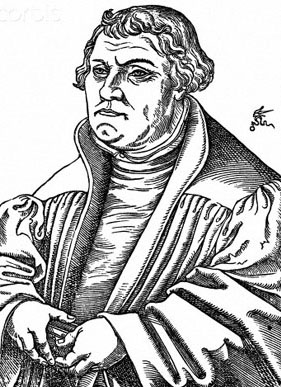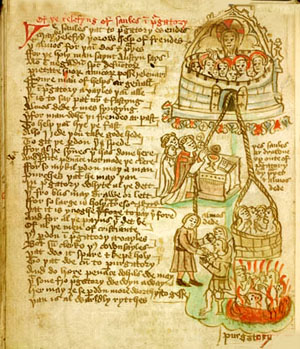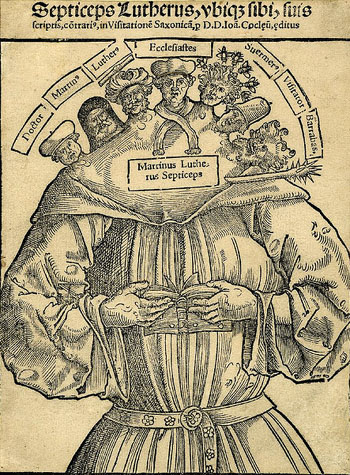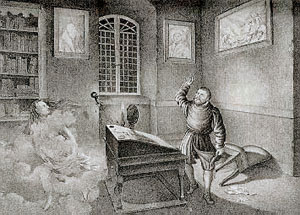 |
Faith under Attack
Luther’s Appalling Instabilities & Contradictions
Fr. Leonel Franca, S.J.
Seeing the despotism exercised by the head of the Reformation in imposing his opinions, as shown in my last article, one might imagine that nothing should be more soundly and painstakingly elaborated than his new doctrine. Such conclusion is completely mistaken.

His doctrine, dictated by personal whims and prejudices |
The false divine messenger, who ‘modestly’ preferred himself to all the Doctors of the Church and pretended to be inspired by the Holy Ghost since he received ‘his dogmas from heaven,’ in reality is insecure, regretful about his early teachings, contradictory and arbitrary. Whether he established dogmas or destroyed them, he was motivated by trivialities and personal prejudices. He changed his opinions like an actor changing his costumes. Here are some examples:
Conditional baptism - On May 12, 1531 Luther wrote to Wenzel Link about conditional baptism, affirming that “after careful consideration we have defined that it must simply be eliminated from the Church.” The next day, he changed his mind. Again ‘inspired,’ he wrote to Ossiandro: “I cannot condemn conditional baptism being given to children whose first baptism is doubtful” (1)
Power of the Catholic Church - In 1519 he wrote: “I fully confess the supreme power of the Roman Church; after Jesus Christ Our Lord, she should be preferred to everything on earth and heaven.” (2) This Church “is the one chosen by God; there can be no reason for anyone to break away from her and, entering into schism, separate himself from her unity.” (3) In 1520, in his Lutheran Epistle, he strongly praised Pope Leo X, saying that his courageous life placed him above any attack. (4)
However, in that same year Leo X would become the Antichrist and the Roman Church “a licentious den of thieves, the most depraved brothel, the kingdom of sin, death and hell.” (5)

A 15th-century English manuscript with Bible verses on Purgatory, which Luther eliminated on a whim |
Saints, purgatory, prayer for the dead - In 1519, two years after he publicly started to preach his Reformation, while defending himself from adversaries, he taught the cult of the saints, the existence of purgatory, praying for the deceased, the practice of fasting etc. (6) Some years later, he rejected all these doctrines as idolatry, superstition and fanaticism.
Indulgences - In 1541 he swore in Christ’s name that when he began to preach against Dominican Johann Tetzel, accusing him of selling indulgences, he did not even know what the word indulgence meant! (7) Notwithstanding, his criticism against those same indulgences - about which he knew nothing - had served as a pretext for him to attack Rome, disseminate his errors and preach the revolt! (8)
Luther’s own mission - Regarding the origin and ‘legitimacy’ of his mission, in a little more than 15 years Luther changed his views at least 14 times (9). Opportunism dictated his choices. To combat Catholics he would say one thing; to defend himself before his Protestant colleagues he would affirm another; he had yet other arguments to calm the turbulence in the new reformed communities. The actor had a well-stocked wardrobe, with costumes for a multitude of roles
It would not be difficult to continue this list of contradictions. There is almost no important dogma about which Luther did not completely change his views from time to time.
Changes motivated by irrational hatred
To understand Luther’s psychology, one must examine the motivation for his constant vacillations. Writing about Communion under one of two species in his liturgical essay called Formula Missae, he stated: “If a council would mandate or allow two species, to show our scorn we would receive only one or neither one nor the other, and we would anathematize those who, following that mandate, would receive both” (10).
On another occasion, he declared that he had decided to do away with the elevation of the host at mass just to show his contempt for the Papacy and that he had conserved the custom up until then just to scorn Andreas Karlstadt [another more radical Protestant who had already abandoned this practice] (11).

A cartoon spoofs Luther's changing nature, showing him with seven different heads |
With similar vileness he wrote in 1523: “If it should happen that one, two, or a thousand and more councils would decide that ecclesiastics should marry, I, trusting in divine grace, would rather forgive the one who has two or three harlots throughout his life than the one who, following that conciliar decision, would take one legitimate wife forever” (12).
The same psychological bias against the hated papists appeared when he wrote: “Since they [the papists] think they are triumphing over one of my heresies, then let me propose another” (13).
What a mixture of vulgarity, licentiousness and duplicity in the supposed “evangelic reformer”!
One other fact should not be forgotten. It is the famous sacramental dispute that divided the innovators Martin Luther and Andreas Karlstadt into two irremediably separated camps, which started with this tavern scene. After a harangue by Luther, the two reformers entered Black Bear Inn in Jura, where Karlstadt declared he could no longer tolerate Luther’s opinion on the real presence. Luther scornfully challenged him to refute his position in writing and promised him a florin if he would do it. He took a coin from his pocket and Karlstadt accepted it.
The wine flowed; the contenders shook hands and drank to each other’s health. This was their declaration of war on August 22, 1523. Karlstadt, bidding Luther farewell, said: “I hope you will be smashed by a roller!” Returning the amiability, Luther replied: “May a thousand lighting bolts strike you before you leave town!”
From this episode Bossuet concluded: “This is the new gospel, these are the acts of the new apostles…” (14)
Changes inspired by the Devil
His reason for suppressing the mass appears to be more ‘supernatural.’ It was the victory of the Devil in a terrible dispute into which Luther had entered with him. Luther himself narrated the episode in detail and then concluded:
“This [surrender] should surprise no one since the logic of the Devil was delivered in such a blood-curdling voice that it nearly froze the blood in my veins. I understood then why some persons die in the night: It is because the Devil can kill and suffocate men, and even if he does not take those extremes, he can entangle them in his disputes with so many obstacles they can cause death: I have experienced this many times” (15).

Luther throwing an inkstand at the devil at Wartburg castle |
Was Luther lying when he described this episode or was he telling the truth? If the latter is the case, what reliance can be put on a man whose teacher was the Father of Lies? Let the admirers of the reformer try to find a resolution for this dilemma…
The episode above is indicative of the important role the Devil played in the interior life of the heresiarch. Indeed, Satan never leaves him alone a moment. He follows him day and night, into both the church and the tavern. More than once Luther stated that his life was “a series of duels” with Satan. He slept with the Devil more often than with his Katerina.
He saw the Devil everywhere: in the cloud that passed, in the lightning that struck, in the thunder that roared, in the forests, waters, deserts, infesting the air and the fields. He saw devils hidden in serpents and lizards, monkeys and parrots, in the fly that rested on his book, even in the walnuts sent by an admirer. The Evil Spirit was the one who routinely resolved every difficult problem for him. To the Devil’s malefic action Luther attributed the moral disorders and social calamities unchained by his subversive doctrines (16).
This diabolic obsession that tortured the soul of the unfortunate renegade can be seen in all of Luther’s writings. Devils dominate in his style; one would say that some of his pages were written in Hell. In the essay against Duke Henry of Brunswick, the Devil is honored by being named 146 times; in the book on the councils he mentioned the Devil 15 times in four lines (17). He accused the adversaries of the Reformation of having “a satanist, super-satanist and hyper-satanist heart.” To Luther must be attributed the initiative of making a new genre of writing fashionable, one dominated by the Devil, whose tune all the other reformers would follow and sing.
Are these uncertainties, doctrinal contradictions, superficiality in inventing and destroying dogmas, and satanic arrogance and language befitting a messenger who proposes to restore Christianity?
Continued
1. Martin Luther, Briefe, Sendschreiben und Bedenken vollstaendig gesammelt von W.M.L. de Wette, Berlin, 1825-1828, vol. IV, pp. 254, 256.
2. Ibid., vol. I, p. 234.
3. M. Luther, Werke, Weimar: Kritische Gesamtausgabe, 1883-1914, vol. II, p. 72.
4. De Wette, vol. I, p. 498.
5. Ibid., vol. I, pp. 522, 500; Weimar, vol. VII, p. 44.
6. Weimar, vol. II, pp. 69-71.
7. Martin Luther, Saemtliche Werke, Erlangern, vol. XXVI, pp. 50-52. In this case, Luther lied, as he often did. At any rate, his character is revealed.
8. We say ‘pretext’ because before 1517, in his commentary on the Epistle to the Romans, Luther had already moved away from the Catholic tradition and was teaching bold errors about concupiscence, original sin, justification, free will and grace. From 1515 on, he was already ripe for apostasy. The preaching of Tetzel only served to trigger that irremediable break.
9. Döllinger, Die Reformation, vol III, pp. 205-207.
10. Cfr. J. B. Bossuet, Histoire des variations des églises protestantes, Charpentier, 1844, I, 2, n.10.
11. Erlangern, vol. XXXII, pp. 420, 422.
12. Weimar, vol. XII, p. 237.
13. Ibid., vol. VI, p. 501.
14. Bossuet, I, II, n. 11; Grisar, Luther, vol. II, p. 321; Weimar, vol. XV, p. 340.
15. De abrogatione missae privatae (Von der Winkelmesse), in Weimar, vol. XXXVIII, p. 198.
16. On Luther’s obsession with demons, see Grisar, Luther, vol. III, pp. 231-257.
17. Erlangern, vol. XXXII, p. 89.

Summarized and translated by the TIA desk from Leonel Franca,
A Igreja, a Reforma e a Civilização, Rio: Livraria Catholica, 1928, pp. 188-191.
Posted December 8, 2010

Related Topics of Interest
 I - Luther’s Lack of Credibility I - Luther’s Lack of Credibility
 II - Luther’s Boundless Pride & Tyranny II - Luther’s Boundless Pride & Tyranny
 Luther Thought He Was Divine! Luther Thought He Was Divine!
 Luther: No, Absolutely No! Luther: No, Absolutely No!
 Card. Willebrands: Luther Is Our 'Common Master' Card. Willebrands: Luther Is Our 'Common Master'
 The October Revolution The October Revolution
 Benedict XVI at the Lutheran Temple Benedict XVI at the Lutheran Temple

| Related Works of Interest
|
Faith under Attack | Religious | Home | Books | CDs | Search | Contact Us | Donate

© 2002-
Tradition in Action, Inc. All Rights Reserved
|
 |
|